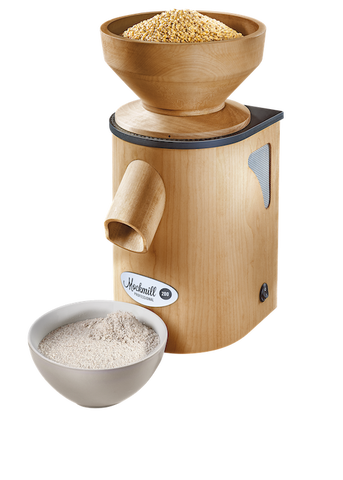Milling grain at home is a great way to ensure that you have fresh, high-quality flour for your baking needs. It also allows you to control the type of grain and the level of fineness you desire. This blog post will discuss the various methods of milling grain at home and the equipment needed to get started.
The first method of milling grain at home is using a hand-crank grain mill. This mill type is the most affordable and easy-to-use option for home milling. Hand-crank grain mills are typically made of wood or cast iron and have two metal plates grind the grain as you turn the crank. This manual method can be tiring, but it is an excellent option for small-scale milling.
Another option for home milling is using an electric grain mill, such as a Mockmill Stone Grain Mill. Electric grain mills are more expensive than hand-crank mills but are also more efficient and convenient. They use a motor to turn the grinding plates, which grind the grain into flour. Electric grain mills come in various sizes, and some even have adjustable settings for the fineness of the flour.
A manual or electric flour mill may not be the best option if you want to mill more significant quantities of grain. In this case, you may consider using a grain roller mill. A grain roller mill uses two rollers rotating in opposite directions to crush the grain. This method is more efficient and can handle larger quantities of grain than a manual or electric mill. However, grain roller mills can be expensive and are not typically recommended for home use.
No matter what method you choose for milling your grain, it is essential to ensure that your equipment is clean and in good working condition. Before you begin milling, clean any dust or debris from the kit. This will ensure that your flour is free from contaminants and will also prolong the life of your equipment.
The options are endless when it comes to the type of grain you can mill at home. Some popular choices include wheat, barley, oats, and corn. Each type of grain has its unique flavour and texture, so it is essential to experiment and find the one you prefer.
When choosing the type of grain you want to mill, it’s a great idea to purchase it in bulk. Buying in bulk will save you money in the long run and will also ensure that you always have fresh grain on hand. When storing your grain, keep it in a cool, dry place to prevent spoilage.
When milling your grain, it is essential to start with a small amount and gradually increase the amount as you become more comfortable with the process. This will prevent waste and help you adjust the settings on your mill to achieve the desired fineness of your flour.
In conclusion, milling grain at home is a great way to ensure that you have fresh, high-quality flour for your baking needs. It also allows you to control the type of grain and the level of fineness you desire. There are many different methods of milling grain at home, including using a hand-crank grain mill, an electric grain mill, or a grain roller mill. Whichever way you choose, ensure your equipment is clean and in good working condition, experiment with different types of grain, start small and gradually increase the amount as you become more comfortable with the process. Happy milling!


